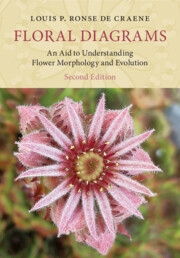Book contents
- Floral Diagrams
- Floral Diagrams
- Copyright page
- Dedication
- Contents
- Preface
- Acknowledgements
- Part I Introduction to Floral Diagrams
- Part II Floral Diagrams in the Major Clades of Flowering Plants
- 4 Systematic Significance of Floral Diagrams
- 5 Basal Angiosperms
- 6 Monocots
- 7 Early Diverging Eudicots
- 8 Basal Pentapetalae
- 9 Rosids
- 10 Caryophyllids
- 11 Asterids
- Part III Conclusions
- Glossary
- References
- Index
8 - Basal Pentapetalae
The Event of Pentamerous Flowers
from Part II - Floral Diagrams in the Major Clades of Flowering Plants
Published online by Cambridge University Press: 11 March 2022
- Floral Diagrams
- Floral Diagrams
- Copyright page
- Dedication
- Contents
- Preface
- Acknowledgements
- Part I Introduction to Floral Diagrams
- Part II Floral Diagrams in the Major Clades of Flowering Plants
- 4 Systematic Significance of Floral Diagrams
- 5 Basal Angiosperms
- 6 Monocots
- 7 Early Diverging Eudicots
- 8 Basal Pentapetalae
- 9 Rosids
- 10 Caryophyllids
- 11 Asterids
- Part III Conclusions
- Glossary
- References
- Index
Summary
The Pentapetalae have diversified very rapidly, leading to two major successful clades, the superrosidae and superasteridae. Although it is still uncertain how the Pentapetalae diverged from ancestral flowers, their regular floral pentacyclic and pentamerous Bauplan is almost unversal and firmly established in all evolutionary lines. The possibility is presented that intermediates such as Berberidopsis regulate the transition from a spiral to a pentamerous pentacyclic flower. The diversity and unique evolutionary trends of early diverging orders with unclear affinity, Dilleniales and Santalales, are presented.
- Type
- Chapter
- Information
- Floral DiagramsAn Aid to Understanding Flower Morphology and Evolution, pp. 172 - 183Publisher: Cambridge University PressPrint publication year: 2022

